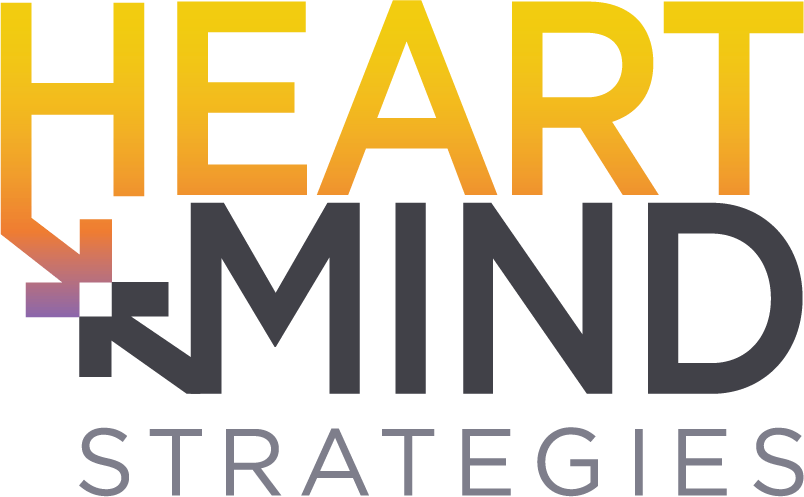The world of work is transforming and generative AI is now at the helm of this sea change. For leaders seeking to navigate this evolution, particularly in the aftermath of COVID’s reshaping of workplace flexibility and productivity, here are the insights from our most recent Heart+Mind Connections session.
We were lucky enough to hear from three panelists at the cutting edge of these two forces reshaping how we get work done: Paul Roetzer, CEO and Founder of the Marketing AI Institute; Barry Jennings of Microsoft; and Helen Kupp, author of “How the Future Works” and co-founder of Women Defining AI.
Setting the Stage for Generative AI Integration
Understanding generative AI’s role in today’s work environment is critical. It’s time to dismantle the myth that AI’s impact is a distant future; it was already budding when machine learning began enhancing marketing with personalization and recommendation engines. What’s different now is the scale and scope—AI is no longer just predicting outcomes; it’s developing vision, language, and reasoning.
But the integration of generative AI is not just about leveraging technology; it’s about setting a new standard for efficiency and innovation. AI is not a distant future; it’s a present opportunity to enhance our work.
Yet, Paul Roetzer pointed out a striking observation—many organizations still lack a comprehensive AI roadmap, one that spans across HR, finance, legal, and beyond.
He urged us to adopt a realistic view, focusing on AI’s current capabilities and the short-term horizon, where use cases should pivot on immediate value—be it through efficiency gains, revenue growth, or productivity.
Paul, a realist in the mix, brought attention to the profound uncertainty clouding generative AI’s impact on jobs. With an estimation that a significant portion of the US workforce are knowledge workers, the potential for AI to streamline their roles is immense, yet uncharted. He warns that without increased demand for their output, the efficiency AI brings could lead to a reduced need for human workers. Paul’s advice for business leaders is to sidestep broad predictions and focus on conducting AI impact assessments tailored to their specific teams, offering a more grounded approach to future-proofing their workforce.
On the flip side, Helen Kupp presented an optimistic scenario, likening generative AI’s advent to the introduction of Excel, which, while it reduced the need for traditional bookkeepers, simultaneously gave rise to new, more analytical roles in finance. She encourages leaders to consider the latent opportunity for growth and evolution within their teams, emphasizing the need to invest in reskilling and nurturing critical ‘power skills’ that AI can’t replicate. The takeaway here is to look for the silver lining in AI integration by fostering a culture of creativity, innovation, and human-centric decision-making.
Barry Jennings, straddling the middle ground, highlighted the importance of change management when introducing generative AI and other AI powered tools into the workplace. He reflected on his personal experience with autonomous features in a Tesla, drawing a parallel to the trust and adaptation required when deploying AI tools in a business setting. His view is that while generative AI can enhance human creativity, it doesn’t replace the fundamental essence of it. Barry stresses that leaders should focus on guiding their teams through the transition, balancing the use of AI with the irreplaceable value of human insight.
RELATED: Can AI Unleash Our Inner Communicators?
A Human-Centric AI Strategy
Barry brought home an essential truth in our webinar: generative AI isn’t a replacement for human ingenuity; it’s a powerful collaborator. This concept isn’t grounded in futuristic visions but in practical, current applications that enhance how we work, especially in a post-COVID landscape.
Drawing from his extensive experience and the rich vein of insight within Microsoft, Barry emphasized the significance of ‘centaur teams’—a blend of AI and human intelligence. He debunked the myth of AI supremacy with a compelling argument: it’s the synergy of humans and AI that triumphs, with evidence backing up this winning combination.
Microsoft’s internal experiments reflect the transformative potential of AI: tasks that took hundreds of hours and sizable budgets can now be initiated by AI, achieving 87% faster results. This isn’t about diminishing the quality of work but shifting where human attention is best invested. It’s about carving out more space for strategic thinking and creative endeavors by offloading the time-consuming, energy-draining tasks to our AI counterparts.
In the AI-enhanced future, Helen argues, the measurement of productivity must shift from hours logged to outcomes achieved. She advocates for a reimagined managerial approach that is outcome-driven, where the value of work is not in the time spent but in the goals accomplished. Generative AI and other AI tools enable this shift by allowing tasks to be completed more efficiently than traditional manual processes.
The strategic integration of generative AI demands a reevaluation of team structures to be more goal-oriented. Managers must balance the capabilities of human workers with technological tools to achieve their objectives effectively. In this new framework, understanding the “jobs to be done” becomes crucial.
Moreover, Helen underscores that as generative AI takes on a more significant role in augmenting work, the human element becomes even more critical. She emphasizes the importance of recognizing where human intervention is most valuable and ensuring that it is incorporated effectively into automated processes.
The future of work must put people first. Generative AI serves as a tool to amplify human potential, where human creativity is matched with AI’s computational power.
Empowerment through AI Literacy and Experimentation
Building confidence in using generative AI is not a luxury; it’s a necessity. Business leaders must demystify AI, foster a culture of experimentation, and share knowledge to empower their teams.
Paul’s approach is rooted in AI literacy and openness. He believes that understanding generative AI is the first step in embracing its potential. By establishing AI councils and fostering cross-departmental conversations, companies can democratize AI knowledge. This collective intelligence then becomes the bedrock for setting ethical AI usage policies. He envisions an era where an organization’s AI principles are as critical as its culture and compensation—central to attracting talent and maintaining competitive edge. Paul’s suggestion to create a culture of experimentation further reinforces the idea that understanding generative AI is an ongoing process, not a one-off event.
Helen amplifies this idea of learning by doing. She points out that the fast-evolving markets necessitate a culture where trial and error is the norm, and ‘prototyping the path’ becomes a mantra. By encouraging teams to take small, manageable steps towards generative AI integration, leaders can transform anxiety into actionable insights. This mindset not only enhances AI literacy but also helps in intuitively reshaping team structures and work processes for greater efficacy.
Progress Requires Action Now
Practical steps toward AI integration in our post-COVID workplace are paramount. This includes starting with a pilot project, establishing ethical guidelines, and promoting cross-functional collaboration. Encourage a blend of creativity, continuous learning, and legal prudence.
Paul emphasized the crucial first step: Choose Your Learning Path. Whether it’s through podcasts, books, or online courses, the key is to actively seek knowledge and become AI-literate. By looking beyond the uncertainty to the opportunities generative AI presents, leaders can foster an optimistic and forward-thinking organizational culture.
Helen advised on Starting with a Project. Pick something manageable within your work context and experiment with generative AI tools to accomplish it. If you hit a roadblock, understand why, and share your learning. This project-based approach acts as a catalyst for building AI literacy and nurturing a culture of shared learning.
Barry’s counsel is to Plan Flexibly and Have Fun. He underscores the importance of always consulting with legal to navigate the complex compliance landscape of generative AI. But, alongside this due diligence, he encourages a spirit of enjoyment in experimentation. It’s in this lighthearted exploration that you’ll find simpler, better ways of working.
For leaders ready to take the plunge into generative AI or to refine their existing efforts, our team at Heart+Mind Strategies is poised to help. Whether it’s aligning AI with your organizational values or resonating with your staff and stakeholders, we’re here to guide you through this exciting journey.
As we wrap up, remember that generative AI is not just a technological upgrade—it’s a commitment to a more flexible, imaginative, and collaborative future of work.

Final Note: 15 Practical Suggestions
The journey into generative AI doesn’t end here. Here’s a summary of practical advice and tips shared by our panelists:
1. Cultivate AI Literacy: Invest time in learning about AI through resources like online courses, podcasts, and books that fit your learning style.
2. Foster Transparency: Communicate your AI plans and progress openly with your team to build trust and understanding.
3. Create a Culture of Experimentation: Encourage trying new AI tools and approaches, learning from both successes and failures.
4. Establish AI Councils: Invite members from different functions to contribute to AI-related decisions and policies.
5. Set Ethical Guidelines: Develop principles to guide the ethical use of AI, ensuring they are human-centered and align with your company’s values.
6. Promote Cross-functional Collaboration: Engage various departments in AI projects to harness diverse perspectives and skills.
7. Prioritize Creativity and Imagination: Value human attributes that AI cannot replicate, and leverage AI to augment these qualities.
8. Prototype the Path: Start small with AI projects, learn by doing, and iterate based on feedback and results.
9. Build a Learning Community: Share knowledge and experiences with AI, fostering a community within and outside your organization.
10. Choose a Pilot Project: Select a manageable project to apply AI, learn its ins and outs, and understand its impact on your workflow.
11. Embrace Flexibility: Stay adaptable in your AI strategy, allowing for shifts as new developments and insights emerge.
12. Consult Legal Expertise: Ensure your AI initiatives comply with current laws and regulations.
13. Inject Fun into Learning: Approach AI with a sense of play to encourage innovation and reduce the intimidation factor.
14. Share Learnings Openly: Use internal channels to communicate what’s working and what’s not, making AI a collective journey.
15. Integrate AI with Employee Flexibility: Explore how AI tools can support the evolving desires for workplace flexibility post-COVID.
